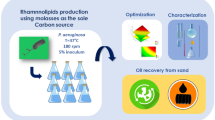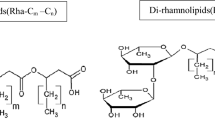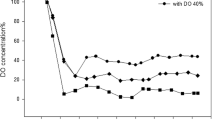Abstract
In recent years, biosurfactants have attracted attention because of their low toxicity, high biodegradability, and good ecological acceptability. However, their production in submerged liquid culture is hampered by the severe foaming that occurs. Solid-state cultivation can avoid this problem. In the current work, we optimized the production of a rhamnolipid biosurfactant by Pseudomonas aeruginosa UFPEDA 614, grown on a solid medium impregnated with a solution containing glycerol. During the study, we increased the production of the biosurfactant over tenfold, with levels reaching 172 g of rhamnolipid per kilogram of dry initial substrate after 12 days. On the basis of the volume of impregnating solution added to the solid support, this yield is of the order of 46 g/L, which is comparable with the best results that have been obtained to date in submerged liquid cultivation. Our results suggest that there is a great potential for using solid-state cultivation for the production of rhamnolipids.



Similar content being viewed by others
References
Benincasa M, Accorsini FR (2008) Pseudomonas aeruginosa LBI production as an integrated process using the wastes from sunflower-oil refining as a substrate. Bioresour Technol 99:3843–3849
Benincasa M, Contiero J, Manresa MA, Moraes IO (2002) Rhamnolipid production by Pseudomonas aeruginosa LBI growing on soapstock as the sole carbon source. J Food Eng 54:283–288
Bordas F, Lafrance P, Villemur R (2005) Conditions for effective removal of pyrene from an artificially contaminated soil using Pseudomonas aeruginosa 57SJ rhamnolipids. Environ Pollut 138:69–76
Costa SGVAO, Nitschke M, Haddad R, Eberlin M, Contiero J (2006) Production of Pseudomonas aeruginosa LBI rhamnolipids following growth on Brazilian native oils. Process Biochem 41:483–488
Das K, Mukherjee AK (2007) Comparison of lipopeptide biosurfactants production by Bacillus subtilis strains in submerged and solid state fermentation systems using a cheap carbon source: Some industrial applications of biosurfactants. Process Biochem 42:1191–1199
Dubois M, Gilles KA, Hamilton JK, Rebers PA, Smith F (1956) Colorimetric method for determination of sugars and related substances. Anal Chem 28:350–356
Durand A (2002) Bioreactor designs for solid state fermentation. Biochem Eng J 13:113–125
Itoh S, Honda H, Tomota F, Suzuki T (1971) Rhamnolipids produced by Pseudomonas aeruginosa grown on n-paraffin. J Antibiot 24:855–859
Karanth NGK, Deo PG, Veenanadig NK (1999) Microbial production of biosurfactants and their importance. Curr Sci 77:116–126
Lang S, Wullbrandt D (1999) Rhamnose lipids—biosynthesis, microbial production and application potential. Appl Microbiol Biotechnol 51:22–32
Lee KM, Hwang SH, Ha SD, Jang JH, Lim DJ, Kong JY (2004) Rhamnolipid production in batch and fed-batch fermentation using Pseudomonas aeruginosa BYK-2 KCTC 18012P. Biotechnol Bioprocess Eng 9:267–273
Lee BS, Kim EK (2004) Lipopeptide production from Bacillus sp. GB16 using a novel oxygenation method. Enzyme Microb Technol 35:639–647
Linhardt RJ, Bakhit R, Daniels L, Mayerl F, Pickenhagen W (1989) Microbially produced rhamnolipid as a source of rhamnose. Biotechnol Bioeng 33:365–368
Maier RM, Soberón-Chávez G (2000) Pseudomonas aeruginosa rhamnolipids: biosynthesis and potential applications. Appl Microbiol Biotechnol 54:625–633
Makkar RS, Cameotra SS (2002) An update on the use of unconventional substrates for biosurfactant production and their new applications. Appl Microbiol Biotechnol 58:428–434
Matsufuji M, Nakata K, Yoshimoto A (1997) High production of rhamnolipids by Pseudomonas aeruginosa growing on ethanol. Biotechnol Lett 19:1213–1215
Meira JA (2007) Produção de biosurfactantes por fermentação no estado sólido e desenvolvimento de aplicações para tratamento de solos contaminados por hidrocarbonetos. Masters dissertation, Universidade Federal do Paraná
Mitchell DA, Berovic M, Krieger N (2000) Biochemical engineering aspects of solid state bioprocessing. Adv Biochem Eng/Biotechnol 68:61–138
Monteiro SA, Sassaki GL, de Souza LM, Meira JA, Araújo JM, Mitchell DA, Ramos LP, Krieger N (2007) Molecular and structural characterization of the biosurfactant produced by Pseudomonas aeruginosa DAUPE 614. Chem Phys Lipids 147:1–13
Mulligan CN (2005) Environmental application for biosurfactants. Environ Pollut 133:183–198
Nitschke M, Costa SGVAO, Contiero J (2005a) Rhamnolipid surfactants: an update on the general aspects of these remarkable biomolecules. Biotechnol Prog 21:1593–1600
Nitschke M, Costa SGVAO, Haddad R, Gonçalves LAG, Eberlin M, Contiero J (2005b) Oil waste as unconventional substrate for rhamnolipid biosurfactant production by Pseudomonas aeruginosa LBI. Biotechnol Prog 21:1562–1566
Ohno A, Ano T, Shoda M (1992) Production of antifungal antibiotic, iturin in a solid state fermentation by Bacillus subtilis NB22 using wheat bran as a substrate. Biotechnol Lett 14:817–822
Ohno A, Ano T, Shoda M (1993) Production of the antifungal peptide antibiotic, iturin by Bacillus subtilis NB22 in solid state fermentation. J Ferment Bioeng 75:23–27
Ohno A, Ano T, Shoda M (1995a) Production of a lipopeptide antibiotic, surfactin, by recombinant Bacillus subtilis in solid state fermentation. Biotechnol Bioeng 47:209–214
Ohno A, Ano T, Shoda M (1995b) Effect of temperature on production of lipopeptide antibiotics, iturin A and surfactin by a dual producer, Bacillus subtilis RB14, in solid-stage fermentation. J Ferment Bioeng 80:517–519
Ohno A, Ano T, Shoda M (1996) Use of soybean curd residue, okara, for the solid state substrate in the production of a lipopeptide antibiotic, iturin A, by Bacillus subtilis NB22. Process Biochem 31:801–806
Trummler K, Effenberger F, Syldatk C (2003) An integrated microbial/enzymatic process for production of rhamnolipids and L-(+)-rhamnose from rapeseed oil with Pseudomonas sp. DSM 2874. Eur J Lipid Sci Technol 105:563–571
Veenanadig NK, Gowthaman MK, Karanth NGK (2000) Scale up studies for the production of biosurfactant in packed column bioreactor. Bioprocess Eng 22:95–99
Yeh MS, Wei TH, Chang JS (2006) Bioreactor design for enhanced carrier-assisted surfactin production with Bacillus subtilis. Process Biochem 41:1799–1805
Acknowledgment
The work was supported financially by Corn Products Brasil and CNPq (Conselho Nacional de Desenvolvimento Científico e Tecnológico, Brazil), a Brazilian government agency for the advancement of science and technology. Research scholarships were granted to David Mitchell and Nadia Krieger by CNPq and to Doumit Camilios Neto by CAPES (Coordenação de Aperfeiçoamento de Pessoal de Nível Superior, Brazil).
Author information
Authors and Affiliations
Corresponding author
Rights and permissions
About this article
Cite this article
Camilios Neto, D., Meira, J.A., de Araújo, J.M. et al. Optimization of the production of rhamnolipids by Pseudomonas aeruginosa UFPEDA 614 in solid-state culture. Appl Microbiol Biotechnol 81, 441–448 (2008). https://doi.org/10.1007/s00253-008-1663-3
Received:
Revised:
Accepted:
Published:
Issue Date:
DOI: https://doi.org/10.1007/s00253-008-1663-3




